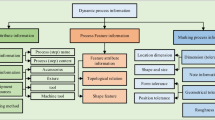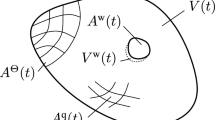Abstract
A new technique is used to design die profiles which yield high process efficiency during axi-symmetric extrusion and wire drawing. These profiles have a convex shape.
The upper bound of the average ram pressure is calculated for the practical range of reductions and optimal die lengths. For m=0,1 where m is the constant friction factor, and up to 55 per cent reduction the reduced extrusion pressure is the same for this convex die and the optimal length cosine die. Above 55 per cent reduction the pressure is slightly higher than that for the cosine die. Up to a reduction of 55 per cent the optimal lengths for this one are slightly shorter than that of the cosine die, while those values for higher reductions are a little higher for this die. The efficiency of the proposed die exceeds those of conventional conical dies.
Similar content being viewed by others
Abbreviations
- Ė:
-
Ėi + Ės + Ėe = total rate of energy dissipation
- Ėi :
-
the rate of energy dissipated within the volume V of the deforming zone
- Ės :
-
the rate of energy dissipation due to shear or friction along surfaces of velocity discontinuity
- Ėe :
-
the rate of energy dissipated along traction-prescribed boundary
- f :
-
flow function
- k :
-
yield shear stress in simple shear
- L :
-
axial length of the die
- m j :
-
constant friction factor along s j
- p :
-
mean extrusion pressure
- pdd :
-
mean drawing pressure
- p en :
-
mean entry pressure
- p ex :
-
mean exit pressure
- R :
-
fractional reduction of area = (R 21 −R 22 )/R 21
- R 1, R 2 :
-
the initial and final radius of the bar respectively
- s, s j (j=1, 2,...):
-
boundary surfaces
- s t :
-
the surface of the body on which surface traction T i is prescribed
- T i :
-
surface traction, prescribed over s t
- v :
-
velocity
- V :
-
volume of the deforming zone
- v r , v z :
-
components of the velocity fields
- v 1, v 2 :
-
the entrance and exit velocity respectively
- v j (j=1, 2,...):
-
magnitude of tangential velocity discontinuities along s j
- Y :
-
yield stress in uniaxial tension or compression = √3k (Mises)
- r, θ, z :
-
cylindrical coordinates
- \(\dot \varepsilon _{ij} ,\dot \varepsilon _r ,\dot \varepsilon _\theta ,\dot \varepsilon _z ,\dot \gamma _{rz} \) :
-
components of strain rate fields
- α :
-
(R 1/R 2)2−1
- \(\dot \varepsilon \) :
-
effective strain rate
- η %:
-
percentage efficiency
- τ j (j=1, 2,):
-
shear stress or frictional tractions
References
Richmond, O. and H. L. Morrison, J. Mech. Phys. Solids 15 (1967) 195.
Sortais, H. C. and S. Kobayashi, Int. J. Mach. Tool Des. Res. 8 (1968) 61.
Samanta, S. K., J. Mech. Phys. Solids 18 (1970) 311.
Chen, C. T. and F. F. Ling, Int. J. Mech. Sci. 10 (1968) 863.
Koshlyakov, N. S., N. M. Smirnov and E. B. Gliner, Differential Equations of Mathematical Physics. North-Holland, Amsterdam, 1964.
Johnson, W. and H. Kudo, The Mechanics of Metal Extrusion. Manchester University Press, Manchester, 1962.
Prager, W. and P. G. Hodge, Theory of Perfectly Plastic Solids, Wiley, New York, 1951.
Shield, R. T., J. Mech. Phys. Solids 3 (1955) 246.
Avitzur, B. Metal Forming: Processing and Analysis. McGraw-Hill, New York, 1968.
Author information
Authors and Affiliations
Rights and permissions
About this article
Cite this article
Samanta, S.K. A new die profile with high process efficiency. Appl. Sci. Res. 25, 54–64 (1972). https://doi.org/10.1007/BF00382284
Received:
Revised:
Issue Date:
DOI: https://doi.org/10.1007/BF00382284




